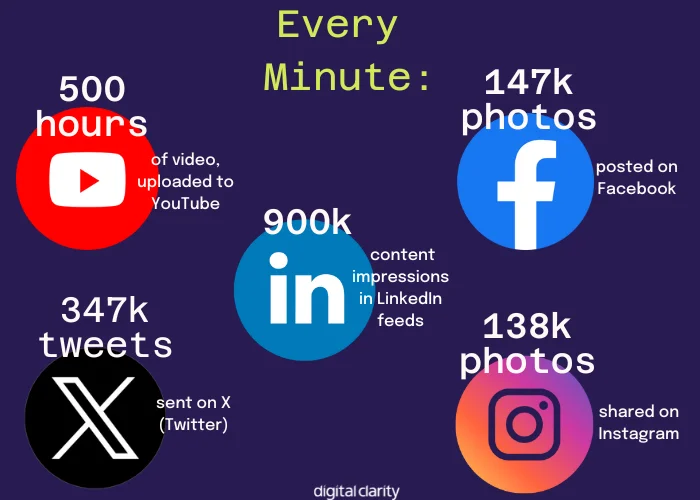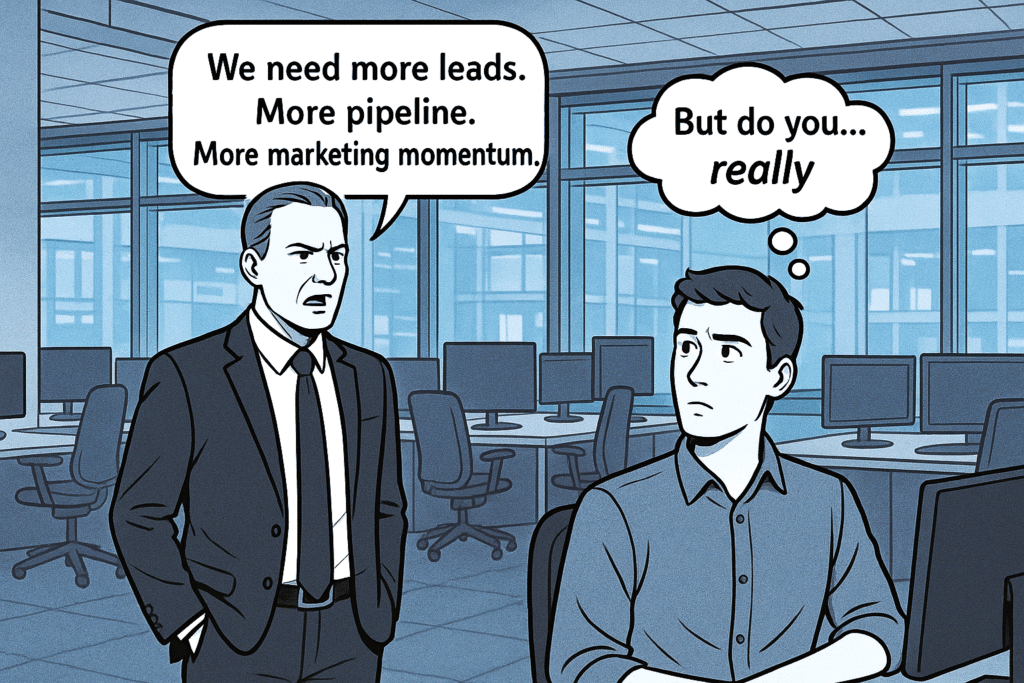The digital age has made content creation accessible to anyone with an internet connection. The simplicity of both accessing and producing content has led to an immense volume of material being produced daily. While this provides a wealth of information, it also creates a significant challenge for marketers: how to make their content stand out in a sea of noise.
Social content saturation
Based on the platforms themself, every minute, approximately:

- 500 hours of video are uploaded to YouTube
- 147,000 photos are posted on Facebook
- 900k content impressions on LinkedIn feeds
- 347,000 tweets are sent on Twitter
- 138,000 photos are shared on Instagram
This means that potential customers are bombarded with information from every direction, making it harder for any single piece to capture and hold their attention.
In particular, in the B2B software space, standing out and differentiating yourself from the next product claiming to solve the same problem can be particularly challenging.
Challenges of Content Saturation
- Short Attention Spans: With so much content available, audiences have developed shorter attention spans, quickly moving on if something doesn’t immediately capture their interest.
- Increased Competition: Brands are not just competing with their direct competitors but with every piece of content that vies for the audience’s attention.
- Content Blindness: Similar to ad blindness, consumers are becoming desensitized to content that doesn’t offer immediate value or differentiation.
Some Key Strategies to Create Standout Content
- Really Know Your Audience
- Audience Research: Use tools like surveys, social listening, and analytics to gain a thorough understanding of your audience’s preferences, pain points, and behavior.
- Ideal Customer Profile (ICP) Development: Create detailed ICPs which focus on all the decision makers and influencers. Tailor your content to the specific needs, pains and interests of your target audience.
- High Quality, Valuable Content
- Focus on Quality Over Quantity: Rather than churning out generic content frequently, focus on creating fewer pieces that offer significant value, are well-researched, and are well-crafted.
- Solve Problems: Content that directly addresses the pain points and challenges of your audience is more likely to resonate and be shared. Don’t be concerned with giving your knowledge for free, you have to share your knowledge to establish your credibility and authority.
- Utilize Engaging Formats
- Visual Content: Visuals can grab attention more quickly than text. Infographics, videos, and images can be used to position your brand, and display complex insights in an easier to consume way.
- Interactive Content: Quizzes, polls, and interactive infographics can engage users more deeply and keep them on your site longer.
- Audio content: Podcasts, videos, or audible case studies can be much more engaging than reading content. It can also be accessible in different environments.
- Leverage Storytelling
- Emotional Connection: Stories can be used to help the consumer visualise and understand the message or concept you are trying to convey. By using emotional content to create a story it can be more memorable.
- Authenticity: Authentic stories that reflect your brand values and realism can resonate with your audience and help to build trust and loyalty.
- Optimize for Search Engines
- SEO Best Practices: SEO isn’t going away anytime soon. And after the recent leak of Google content it goes to show there are still fundamentals you need to take onboard. Implement SEO strategies to ensure your content is discoverable. Use keyword research to understand what your audience is searching for and optimize accordingly.
- Internal linking: Organize your content by linking internal relevant pages to each other. This creates a path not only for Google to follow relevant pages and anchor text, but also for the user to navigate pages of the website. All of which helps make it easier for your audience to find relevant information.
- Promotion and Amplification of Content
- Multi-Channel Distribution: Content should be positioned for the relevant platforms. Users consume content differently on various platforms, so the format, look, feel and even tone may need to be different to suit the audience at the right time in the right place. Share your content across multiple platforms where your audience is active, including social media, email newsletters, and industry forums to get the most reach and exposure.
- Influencer Partnerships: Collaborate with influencers or connections who can help amplify your content to a broader audience. Online networking and groups can help you reach these audiences. Commenting and sharing content of those partners can also help you get on the radar of new users.
- Measure and Adapt
- Analytics: Use analytics platforms to track the performance of your content. Its not just about engagement, shares, and conversions as many people may think. If you are appearing in front of the right audience, with the right message, they may not be ready to engage yet. So reach, and relevance of the audience may be as important. Also each piece of content may have a different goal and be working a different step of the buyer journey – so map out your KPIs against each one – know what success for that post looks like. Importantly – if your content isn’t getting reach, then it wont get engagement. So male sure before writing it off, you have distributed it in the best way first.
- Feedback Loop: Continuously gather feedback from your audience based on KPIs and engagement and be willing to adapt your strategy based on what you learn.
Conclusion
In an era where content is everywhere, standing out means having a smart plan. This involves knowing your audience well, creating high quality and engaging content, promoting it strategically, consistently and constantly adapting.
By providing real value and emotionally connecting with your audience, marketers can create content that not only grabs attention but also builds strong, lasting relationships.



